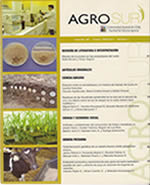Content and stability of chlorophyll and carotenoids in lettuce juice (Lactuca sativa L.)
Main Article Content
Abstract
Degradation dynamics was studied in a new antioxidant format to use natural juice of lettuce (Lactuca sativa L., Cv. Justine) in human diets as a functional food. Chlorophylls a, b and carotenoids content and stability were quantified and characterized under pH-medium and temperature conservation techniques for ten days. A 3x3 factorial ANOVA arrangement design was used. The first and second factors were the juice storage temperature (5, 20 and 35 °C), and the liquid pH-medium (without additives, 4,5 and 7,5), respectively. Significant minimum differences were achieved by means of Tukey’s multiple comparison test (α = 0.05).
Significant differences were found on pigment concentrations between pH factor versus temperature. The storage temperature x liquid pH-medium interaction was signficant and showed that chlorophylls a and b and carotenoids maintained greater stability in alkaline solutions and temperatures close to 20 °C. The most important conservation factor was pH. The results allowed to conclude that there is wide variation between pigment types, highlighting chlorophyll b that had a more desirable behavior at higher temperatures. In general, there were evident decreases in pigment concentration from five days of storage, suggesting a potential use of lettuce juice as a functional ingredient in human diets.

